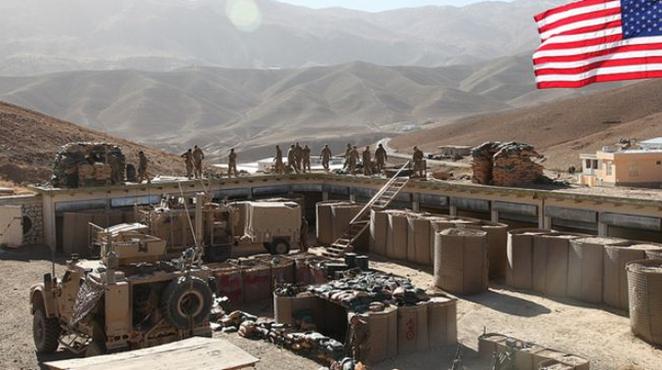[captionpix imgsrc=”https://pvnn.org/wp-content/uploads/2015/09/zuckerbases.jpg”]
The United States military maintains eight hundred bases on six continents. The cost to the American taxpayer is around $100 billion each year, even though countries like Germany, Japan, and South Korea subsidize our military presence. [ref]Representative J. Randy, “Puncturing the U.S. Base Myths,” The Diplomat, Dec. 2, 2011, accessed Sept. 11, 2015.[/ref] The majority of these foreign governments want the US presence, though their citizens are more skeptical of our motives. The vendetta is determining which bases are necessary for national security and which are leftovers from an earlier era that can be closed.
America’s withdrawal from the global stage following World War I resulted in a lack of military power or presence to deter the aggression of Nazi Germany and Imperial Japan in the late 1930s. As World War II ended, the Truman Administration chose to maintain American military forces in Europe and Japan as the US rebuilt but continued to monitor its former enemies. When the Cold War emerged, the US turned its attention to containing communism. America required a powerful international presence to achieve this goal, and established military bases all over the world.
America’s military has intervened in dozens of countries since World War II. This usually requires the military to establish a base within the region of interest. With few exceptions, the military never leaves these regions. The host governments view American presence as useful for economic and security purposes. In fact, “many of the host countries specifically ask for more U.S. involvement.” [ref]Tim Hibbits, “Why Does the U.S. Have So Many Military Bases Abroad?” July 24, 2015, accessed Sept. 11, 2015.[/ref] With the exception of Cuba’s demand that it close the base at Guantanamo Bay, the US has complied whenever a host government asks for the American military to leave. When the Cold War ended, and the threat of communist aggression ebbed, the Philippines asked America to withdraw its forces. America agreed, and has not returned, despite requests from Manila.[ref]Representative J. Randy, “Puncturing the U.S. Base Myths,” The Diplomat, Dec. 2, 2011, accessed Sept. 11, 2015.[/ref]
There is bipartisan agreement that something has to be done about the issue of America’s overseas military bases. Money spent maintaining these bases could be used to help balance the budget. Critics ask, “whether we need military bases outside the United States in an era where technological advancements have allowed the U.S. military to deploy forces from the continental United States just as quickly as from most bases overseas.”[ref]David Vine, “Do America’s Military Bases Abroad Help Or Hinder Global Security?” NPR, Aug. 23, 2015, accessed Sept. 11, 2015.[/ref] Although the host governments want American military presence, it is debatable whether the citizens of these countries want the US present. Many are uncomfortable with a foreign military occupying their land. Further problems occur when there are, “a number of harms that these bases have inflicted on local communities — there have been accidents, crimes committed by US personnel, environmental damage — a whole range of damage that people were quite upset about.”[ref]Ibid.[/ref] These controversies have led some critics to suggest the total dismantlement of America’s foreign military bases, claiming that the United States has become a global imperialist power similar to the former British Empire.
An objective view suggests that some of these bases are beneficial to the United States and the world. America has 28,500 soldiers in South Korea. They have been there since the Korean War, and they deter aggression from North Korea. If America withdrew from South Korea, America would lose influence in East Asia and South Korea could be vulnerable to attack. Other military bases that need to be maintained are the drone bases in the Horn of Africa. American drones take off from these bases and are vital in the war against radical groups like al-Qaeda and ISIS. Dismantling these bases would create logistical problems in the War on Terror. The drone that assassinated “radical al-Qaeda preacher and American citizen Anwar al-Awlaki in Yemen”[ref]Nick Turse, “How America Operates Its Drone Empire,” Saloncom RSS, Oct. 17, 2011, accessed Sept. 13, 2015.[/ref] took off from a base in Afghanistan. Drones currently have limited flight and attack capability and could not be launched successfully from the continental United States. “The flexibility afforded to U.S. forces to operate from a network of overseas facilities allows them to quickly respond to any regional crisis as it is emerging. Constraining U.S. forces to a continental posture would undermine this very advantage, placing a geographic burden on them.” [ref]Representative J. Randy, “Puncturing the U.S. Base Myths,” The Diplomat, Dec. 2, 2011, accessed Sept. 11, 2015.[/ref]
Instead of closing all of our foreign military bases, a pragmatic policy would be to individually analyze each base and judge whether the base truly benefits America’s national interest. Some bases are mere leftovers from an earlier era and are no longer vital. These should be dismantled to reduce spending and ease tension with local populations. Others offer easy access to critical regions and ease geographic hurtles. Since American global leadership is indispensable for international stability, some overseas military bases are needed. The key is for the Pentagon to decide which ones remain truly necessary.
Take Action:
To support closing down unnecessary military bases, sign this petition.




